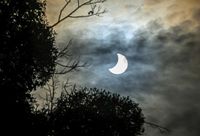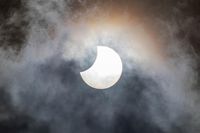On Saturday, March 29, 2025, a partial solar eclipse will grace the skies over Poland, offering a unique astronomical event for enthusiasts and curious onlookers alike. The maximum phase of the eclipse in Lublin is expected to cover about 5% of the Sun's disk at precisely 12:29 PM, making it a moment worth witnessing.
The eclipse will commence at 11:55 AM and conclude at 1:02 PM, lasting approximately one hour and seven minutes. As the Moon passes between the Earth and the Sun, it will obscure a small portion of the solar disk, creating a spectacle that, while not as dramatic as a total eclipse, still holds significant allure.
Karol Wójcicki, an astronomy enthusiast known for his profile "Z głową w gwiazdach," emphasized the importance of this event, stating, "While it may not be as spectacular as a total eclipse (we're saving that for 2026 in Spain!), the partial embrace of the Sun by the Moon is still deserving of our attention." Wójcicki noted that the best viewing conditions will be in the northwestern regions of Poland, where the eclipse will be most pronounced.
In Lublin, the eclipse will be observed at Plac Litewski, where telescopes will be set up for public viewing, provided that the weather cooperates. The event will feature a Newton telescope with an ND5 filter for visual observations and photography, as well as a Lunt 50 mm telescope that will stream images to a laptop. In case of logistical issues, the organizers may focus solely on transmitting images from the Lunt telescope.
Weather conditions are a crucial factor for observing the eclipse, and forecasts predict that the eastern and northeastern parts of Poland will experience the least cloud cover, offering the best opportunities for viewing. Conversely, areas in the west and south are expected to have more clouds, reducing visibility chances. Temperatures across the country are anticipated to reach between 15 to 17 degrees Celsius, with cooler conditions in mountainous regions.
Safety is paramount when observing solar events. Experts warn against looking at the Sun directly, as it can cause severe eye damage. The best protection comes from solar viewing glasses equipped with an ND5 filter, readily available in astronomy shops. "Under no circumstances should homemade methods, such as using tinted glass or photographic film, be employed, as these can severely harm eyesight," cautioned experts.
As for the scientific aspect, solar eclipses occur when the Moon aligns perfectly between the Earth and the Sun, blocking the Sun's light either partially or fully. This particular event is classified as a partial eclipse, where only a fraction of the solar disk is covered. The rarity of such events at specific locations is attributed to the Moon's tilted orbit relative to the Earth's orbit.
"The Moon is about 400 times smaller than the Sun but is also approximately 400 times closer to Earth, making them appear nearly the same size in the sky. This unique alignment allows us to witness such captivating solar eclipses, whether partial, total, or annular," explains Professor Tomasz Bulik, director of the Astronomical Observatory at the University of Warsaw.
Looking ahead, the next total solar eclipse visible to Europeans will occur on August 12, 2026, with visibility from locations such as Iceland, Greenland, Portugal, and Spain. In Poland, the next partial solar eclipse will take place on the same date in 2026, while a total solar eclipse will not be visible until October 7, 2135.
In summary, the partial solar eclipse on March 29, 2025, presents a wonderful opportunity for both seasoned astronomers and casual observers to engage with the wonders of the universe. Whether through telescopes at public viewing events or personal observation, this celestial phenomenon is sure to inspire awe and curiosity.







